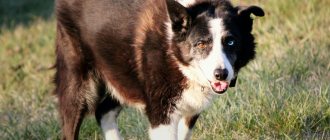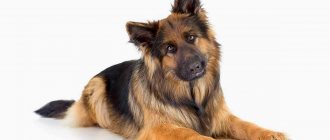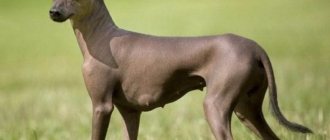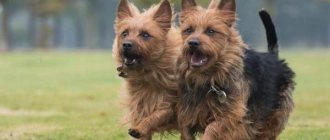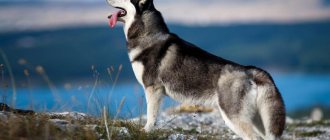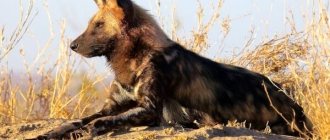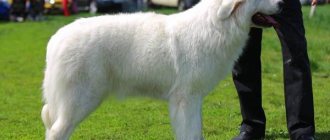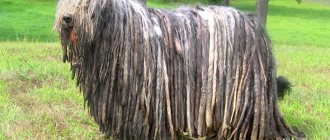The wolf is the largest predator of the canine family. The closest relatives of wolves are the coyote and the jackal, which are also members of the genus of wolves. The wolf is the ancestor of the domestic dog, which is considered by scientists to be a subspecies of the wolf. Wolves form packs in which there is a clear hierarchy. A pack of wolves living near a populated area can cause serious damage to domestic animals or even attack a person. The wolf has long been an enemy of man, and has been hunted for a long time. Let's talk about wolves in more detail.
Appearance
The wolf is the largest animal in the canine family, not counting some large breeds of domestic dogs, in appearance it resembles a large dog, which is not surprising, since wolves are the ancestors of domestic dogs.
Most wolves are medium and large-sized predators, the body length of a wolf can reach up to 110-160 cm, the height of a wolf at the withers can be from 60 to 90 cm. The length of the tail is up to 52 cm.
The body weight of a wolf reaches 80 kg, there are some references to wolves reaching a weight of 90-100 kg. The usual weight of a mature (one-year-old) wolf is 20-30 kg, the weight of a mature wolf (2-3 years old) is 35-45 kg, the weight of a seasoned wolf (over 3 years old) is 50 kg or more.
The size and weight of wolves strongly depend on the geographical location of their habitat and correspond to Bergman's rule: the colder the climate, the larger the animal. That is why the largest wolves live in Siberia, Canada and Alaska. In 1939, a wolf weighing 80 kg was killed in Alaska. There is evidence that a wolf weighing 92 kg would be killed in Siberia.
An ordinary wolf from Europe most often weighs about 38 kg, a wolf from North America weighs 36 kg. The smallest wolves live in India and the Arabian Peninsula, their usual weight is 25 kg, and the female weighs even less, her weight is only 10 kg.
Females differ from males in their appearance; they are smaller in mass and size by about 20%, in addition, they have a smaller forehead.
Wolves are very strong animals; they have such strength that they can turn over the frozen carcass of a large wild boar or elk.
The wolf's head is massive, broad-browed, with high-set triangular ears that resemble the ears of huskies or German shepherds. The wolf's muzzle is wide, elongated, and has sideburns on the sides. The muzzle of a wolf is very different from that of a jackal or coyote, which is sharper and narrower. The large muzzle of a wolf is very expressive; a wolf can express more than 10 emotions with its facial expressions: anger, anger, affection, fun, alertness, humility, threat, calm, fear. The wolf's cheeks are almost white, and there are light spots in the eye area. The nasal opening is wide, widening downward.
Females have a narrower muzzle, with a narrower forehead and a thin neck.
The wolf's eyes see perfectly in the dark, thanks to a reflective layer that glows in the dark.
The wolf looks like a powerful and dangerous predator, slender, with a strong powerful physique, muscular neck and retracted belly. In the process of evolution, the wolf received a deep-set, narrow and streamlined chest, high strong legs, and a sloping back, all this allows the wolf to cover long distances in search of prey.
A wolf's teeth play an important role in its life. They are capable of withstanding a load of more than 10 megapascals and are both a weapon of attack and a means of defense for the wolf. Loss of teeth leads to starvation and subsequent death of the wolf.
The cleft palate contains 42 teeth, 20 in the upper jaw and 22 in the lower jaw. The wolf holds and drags its prey with its fangs. With the rest of its teeth, the wolf butchers the prey, tears it into pieces and grinds the bones.
The wolf's tail is quite long and thick, it can reach up to 52 cm in length. Unlike a dog's, a wolf's tail is usually lowered down, which is why hunters call it a “log.”
The tail reflects the mood of the wolf; by its position and movement, one can determine the emotional state of the wolf, whether he is afraid or calm, and the tail also allows one to judge the position of the wolf in the pack.
The wolf's fur is thick, quite long and very warm. It consists of two layers, which is why the wolf looks much larger than it actually is.
The outer layer of the coat is made up of tough guard hairs that repel dirt and water. The second, inner layer is the undercoat, which is waterproof down that protects the wolf from the winter cold.
The undercoat has maximum density in winter, thanks to it, in northern latitudes, wolves can easily stay in open areas at temperatures down to minus 40 degrees. In severe frost, the wolf hides its muzzle between its hind legs and covers it with its tail. The low thermal conductivity of wolf fur provides better protection from the cold than the fur of a dog, muskrat or beaver and allows the wolf to survive in the harshest climatic conditions
At the end of spring, the wolf begins to shed, the fluff of the undercoat begins to flake off from the body, and in order to quickly get rid of it, the wolves rub against stones, branches and tree trunks. The undercoat grows back in the fall to again protect the wolf from winter frosts in winter.
The color of a wolf's fur has a large number of shades, including gray, white, black, red and brown. Differences in color relate only to the outer layer of fur; the undercoat of all wolves is always gray.
The complex color of a wolf's fur allows it to blend into its environment, acting as camouflage; in addition, the mixture of different colors and shades, individual for each animal, allows wolves to distinguish one wolf from another.
The color of a wolf's fur depends on its habitat. Wolves living in forests most often have a gray-brown color. Wolves living in the tundra have a light, almost white color. Wolves living in the desert have a grayish-red color. In the mountains of Central Asia, wolves have a bright ocher color. Arctic wolves are almost entirely white.
Wolves have long and strong legs, with fairly small paws. The front paws are larger than the hind paws and have five toes. The hind legs have four toes. Wolves have small membranes on their paws and between their toes; they reduce the specific load of the paw on the surface, thanks to which the wolf does not fall through and moves much faster than its victims in deep snow.
The wolf's paw is designed in such a way that when moving, the wolf does not rely on the entire paw, but only on the fingers, which helps him better balance his weight.
The bristly fur on the paws and claws help the wolf not to slip when moving on the snow crust.
The circulatory system of a wolf's paws is designed in such a way that the wolf can reduce the flow of blood going to the paws in order to maintain heat throughout the body.
Between the wolf's toes there are scent glands that leave identification marks behind him, which he or other members of his pack can use to navigate the area.
The wolf is a fast and hardy predator. He can trot at a speed of 10 km/hour and cover a distance of several kilometers. In one night he can make a journey of 60-80 kilometers, and during a chase he can gallop to a speed of 60 km/h, making jumps of 4-5 meters.
What does a gray predator look like?
The wolf is a large four-legged carnivorous mammal. It has pointed, erect ears, an elongated snout, and a bushy tail, often with a black tip. A narrow chest, powerful back and long strong legs help the animal move efficiently.
Wolves and dogs are similar in many ways, but in most cases our heroes are larger animals and have longer legs.
Most wolves have fur that is quite long (up to 8 cm), thick and coarse. The color of summer and winter wool is somewhat different. In the warm season, it is dominated by rusty ocher and gray tones, which are darkened by the black ends of the hair, especially on the back. Winter fur is lighter and fluffier. Among these animals, sometimes there are individuals with black-brown, reddish and pure white fur. The coloring of different subspecies has its own nuances.
The lightest wolves live in deserts and the Arctic. In Russia, you can find mostly gray-brown specimens.
The size of these animals varies depending on their habitat. Animals living in the northern parts of their range are usually larger than southern specimens. The average body length is from 90 to 160 cm, the tail length is 30-60 cm, and the weight of the animal is 31-66 kg. Seasoned wolves can reach 1 meter at the withers and weigh 75 kg.
The smallest individuals are found in deserts and semi-deserts, and the largest are found in tundra zones. Animals that live in forests are of medium size.
One of the largest wolves was caught in Alaska in 1975. He weighed 79 kg.
Wolf tracks
In winter, when moving through deep snow, wolves walk in single file. One wolf follows another, following in the footsteps of the previous wolf. Therefore, it is very difficult to find out the number of wolves in a pack from their tracks.
The track of the wolf's tracks is very smooth, it looks like an almost straight line. This is a sure sign that allows you to distinguish the track of a wolf from the track of a dog.
The footprint of an adult wolf has a length of 9.5-10.5 cm, a width of 6-7 cm; the tracks of a she-wolf are much smaller in size, the length of the trace is 8.5-9.5 cm, the width is 5-6 cm.
The wolf keeps its paw in a ball, so the wolf's footprint is more prominent than that of a dog's. In addition, the wolf has two middle fingers forward, and two side fingers set back. If you draw a straight line between the tips of the lateral fingers, then on a wolf the bases of the middle fingers will only slightly extend beyond this line, and on a dog there will be about a third of the pads of the middle fingers behind the line.
Common jackal
This small animal is also called “bark san”. The jackal is found in South Asia, however, not so long ago, it was widespread in some European countries, for example, in Albania. The jackal is very similar to a dog. It's smaller than, say, a dingo, or even a standard mongrel.
Its body weight is much less than that of the gray wolf, up to 20 kg. The jackal's muzzle is pointed and oblong, like a fox's. The fur of this "reduced wolf" is brownish-gray in color. In winter it becomes smoother. During the day, Kora San almost never eats, choosing to eat in the evening. He eats:
- Fish;
- Bird;
- Carrion;
- Snails;
- Frogs;
- Bugs;
- Berries;
- Snakes, etc.
It turns out that the jackal is practically omnivorous. He rarely hunts with his own kind. Despite its small size and lack of wolf endurance, a sharp mind and dexterity help the jackal to be a good hunter. It can silently sneak up on its prey and easily grab it before it can escape.
Wolf howl
The range of sounds made by wolves is extremely rich and varied. In terms of their vocal capabilities, they are superior to most animals. Wolves howl, howl, grunt, yap, squeal, growl, bark and whine. Moreover, each sound has a large number of shades.
The most known to people and heard over a long distance, of the sounds produced by wolves, is the wolf howl.
Wolves howl at dawn or in the late evening hours, but not every day. Wolves begin to howl towards the end of summer and the beginning of autumn; wolves howl most often in winter, when they stay in large packs.
The howl is intended for communication between wolves over a long distance; with the help of howl, wolves find out where the members of their pack are, gather the pack before and after the hunt, announce the capture of prey, warn rivals from other packs about the seizure of territory, and look for individuals of the opposite sex.
A wolf howl usually begins with the howl of the leader of the pack, and is later joined by other members of the pack. The howl of mature males, she-wolves and young animals is very different from each other. The howl of a wolf pack usually ends in a yelping, shrill bark.
With the help of howls, wolves can transmit even very complex information to other wolves, for example, about the location of prey in a certain place or about the appearance of people. In this case, the wolf first listens to information from another wolf, which may be 8 kilometers away, and then throws its head back and emits a vibrating howl, low at first, then ending on the highest note.
The wolf howl lasts no more than 5 seconds, just because of the echo the sound seems longer.
Lone wolves living outside the pack rarely howl so as not to endanger themselves.
During their hunt, wolves move silently and do not make any sounds so as not to attract the attention of the prey to their presence.
When the pack is ready to attack its prey, the leader of the pack emits a war cry, which is similar to the growl of an angry dog rushing at a person, this is a signal to the pack to attack the prey.
Some people not only know how to understand the sounds made by wolves, but also know how to skillfully imitate wolves, communicating with wolves using howls.
Eye color
All wolves have blue eyes at birth. But by the 3rd month it changes to gold. Although there are exceptions when wolves spend their entire lives with blue eyes.
Look - Giraffe - species, range and habitats, lifestyle and interesting information about the tallest animal on the planet (110 photos)
Facial expressions of wolves
The facial expressions of wolves are also very developed: thanks to the position of the mouth, lips, ears and tail, as well as the display of teeth, predators express their emotional state.
Like a domestic dog, a wolf's raised tail and ears indicate wariness or aggression.
The body language of wolves consists of various expressions of the muzzle and tail position.
An aggressive or defensive wolf is characterized by slow and deliberate movements, a high posture and raised hair; calm wolves have a calm posture, smooth hair, drooping ears and tail.
Wolf sense organs
Of the sense organs, the wolf has the best developed sense of smell, second is hearing and last is vision.
Recent studies show the enormous importance of smell for a wolf; when observing a pack of wolves, in 82% of cases wolves detected an elk by scent and only in 18% of cases by hearing.
The wolf has an amazing sense of smell, which is 100 times better than that of a human. A wolf can detect prey at a distance of 3 kilometers. Wolves distinguish 200 million types of odors, compared to humans only 5 million. It is through smell that the wolf receives most of the information about the world around it.
Urine and fecal marks play a major role in the life of a wolf. With the help of such marks, the wolf transmits and receives information about the species and sex of the animal that left such a mark.
Hearing also plays a big role in the life of a wolf. Wolves are able to hear sounds at a distance of 9 kilometers in the forest and at a distance of up to 16 kilometers in open areas.
Video
And in conclusion, we invite you to watch an interesting film about wolves from the National Geographic channel - “The Rise of the Black Wolf.”
Author: Pavel Chaika, editor-in-chief of Poznavaika magazine
When writing the article, I tried to make it as interesting, useful and high-quality as possible. I would be grateful for any feedback and constructive criticism in the form of comments on the article. You can also write your wish/question/suggestion to my email [email protected] or Facebook, with respect, the author.
Author page
Area
The wolf is the most common land predator. Historically, the range occupied by the wolf was second in area after the range of humans. Nowadays, the wolf's range and its total number have decreased significantly, the main reason for this being human activity: changes in the natural environment, urban development and the extermination of wolves as a result of hunting them.
In many regions of the world, the wolf is on the verge of complete extinction, but in the north of Eurasia and America there are still many wolves.
In Europe, the wolf is found in Spain, Portugal, Italy, the Baltic countries, Russia, Belarus, Poland, the Scandinavian countries, the Balkans, and Ukraine.
In Asia, wolves live in Korea, parts of the territories of China and India, the Caucasus, Kazakhstan, Kyrgyzstan, Afghanistan, Iran, Iraq, and the north of the Arabian Peninsula.
Throughout North America, from Alaska to Mexico. In Africa, wolves are found in Ethiopia. In South America: Brazil, Bolivia, Paraguay.
In terms of numbers, the most wolves are in Russia - 70 thousand, in Canada and Alaska 50 thousand, in the United States 6500 wolves, in Spain 2000 wolves, in Poland 700 wolves, in Italy 300 wolves, in Norway and Sweden about 80.
Habitats
Wolves live in a variety of natural zones: tundra, forest-tundra, steppe, forest-steppe, semi-deserts, avoiding dense forests. It can settle in the mountains, from the foot to the alpine meadow zone. A wolf can settle near human habitation. In the taiga, the wolf spread after humans, as taiga forests were cut down.
Wolves make dens for breeding; for this they most often use natural shelters: crevices in rocks, thickets of bushes, overgrown ravines. Wolves can occupy the burrows of badgers, marmots, arctic foxes and other animals. Wolves themselves dig holes extremely rarely. The female is most attached to the den when raising wolf cubs; the male is not attached to the den. As soon as the wolf cubs grow up, the wolves stop using the den. Wolves never hunt near their den, but hunt at a distance of at least 7-10 kilometers from it.
Dingo
Until now, biologists have not come to a consensus regarding the classification of dingoes. Some believe that the animal is a feral dog, in no way related to the wolf, while others believe that the dingo is a completely independent “wolf” species. One way or another, there is a version that he is a descendant of the Indian wolf, and a purebred one. Therefore, this animal is discussed in the article.
The species is widespread in Australia and Asia. Dingo is even found in New Guinea. It is a well-built, nocturnal predator with dense red fur. But the dingo also has white hair on its body (on the edge of the muzzle, tail and sternum). In New Guinea, there are also dark dingoes, with brown or even black fur.
Despite its "canine" nature, this type of animal never makes a sound reminiscent of a dog barking. But he howls by analogy with a wolf. This red animal settles near a pond. As a place to spend the night, dingoes choose large wooden hollows, holes or caves.
Interesting! Asian representatives of this species are not afraid of people, but, on the contrary, prefer to stay close to them. The fact is that people often feed dingoes. By the way, the red wolf-dog unites with its own kind, creating small groups. Only the leader and his female have the right to reproduce.
Wolf Pack
The wolf is a social animal and lives in packs. A wolf pack is a family group of wolves, which includes animals of different sexes and ages. A wolf pack can include from 3 to 40 wolves. At the head of the pack is the leader, this is a seasoned wolf, the dominant alpha male. The leader in the pack has unquestioned authority; he is the most intelligent, experienced and powerful male in the entire pack. The leader is friendly towards members of his pack, but extremely aggressive towards strangers. The leader's girlfriend is the alpha female. The remaining members of the pack: the offspring of the main pair, their relatives and lone wolves that have joined the pack.
A beta male is often present in a pack, a wolf ready to replace the leader of the pack. Most often this is either the son of the alpha male or his brother. The beta male from time to time demonstrates aggression towards the leader of the pack, indicating that he is ready to replace him at any time.
Each pack of wolves has its own territory, its own hunting area, which is carefully guarded from other wolves and hunts only in it.
Wolves mark the boundaries of their territory with odorous marks, as well as by leaving scratches with their claws on fallen trees and old stumps. When moving through its territory, the leader of the pack leaves scent marks every 3 minutes. There are especially many marks on the border of the territory. A wolf pack indicates its territory by howling.
The size of the territory occupied by a pack of wolves can range from 50 to 1500 square kilometers. In the open spaces of the tundra and steppe, the size of a wolf's hunting area is 1000-1250 square kilometers; in the forest zone its size is significantly less than 200-250 square kilometers.
Wolves gather in packs only in winter; as soon as spring comes, the wolf pack disintegrates, the territory is divided into several areas, of which the best goes to the dominant pair, the rest of the wolves switch to a semi-vagrant lifestyle.
Social behavior and characteristics
Wolves live in packs of 2 to 20 animals. Usually a pack is a large family consisting of parents and children of several generations, but sometimes animals that are not related to it join the pack. They remain as “uncles” and help raise the young, hunt and protect the area. The basis of the family is a breeding couple, which most often remains for life, unless one of the partners dies (photo 7, 12). Each family assigns and protects a certain feeding area, where “strangers” are not allowed. Wolves mark the boundaries of their territory with odorous marks - they spray stumps and large stones with urine - and notify neighbors of their rights by howling.
Wolf howling is a truly magnificent method of communication. A person hears it 3-4 km away, the wolves themselves hear it 10 kilometers away. Thanks to the howl, the members of the pack always know where each of them is, what he is doing, and where his neighbors are hunting. The parents howl to inform the puppies that they are approaching with prey, and the kids tell them where they are. With the help of their voice, animals are able to transmit more complex messages to each other, for example, about the location of potential prey or about the appearance of people. But the most important thing is that it is the howl that creates a general harmonious mood in the flock and supports its desire for unification (photo 4, 5, 6).
The position of the wolf in the pack is indicated by its facial expressions, postures, movements, and the position of the ears, head, tail, lips, and fur are important. A self-confident wolf shows with all his appearance how big, strong and powerful he is - therefore he walks with a straight back and head held high, and his tail either lifts up or stretches horizontally, and he holds his ears up. Threatening the disobedient, he bares his fangs, while raising, but not stretching, his lips. But such extreme measures are resorted to quite rarely in a friendly flock. Most often, to put a subordinate in his place, just a gaze is enough. Wolves often express friendly feelings towards their relatives, which is very important for the unity of the pack. The easiest way to relieve stress and spread a good mood is through play, and wolves love to play (photos 8, 9, 10). They have a form of mutual collective greeting: whining, wolves excitedly rub against each other, push, and lick each other’s faces (photo 12). This ceremony, like the group howl, lifts the general mood.
Wolves are skilled and resourceful hunters, they are highly intelligent, and their behavior is highly complex and coordinated. In a pack chasing an elk or deer, some predators often run after the prey, others run across it, and others sit in ambush in order to make a decisive charge at the right moment.
8854
1388
1389
1390
1391
1392
1393
1394
Wolf video
What does a wolf eat?
The wolf is a predator that obtains food by actively searching for and pursuing victims. The basis of wolves' diet consists of large ungulates: in the tundra - reindeer, in the forest zone - elk, wild boar, deer, roe deer, in the steppes and deserts - antelope, saigas, rams, goats. Sometimes the size of large ungulates that wolves hunt is 10-15 times larger than the size of the wolf itself.
The wolf has always been attracted to large concentrations of livestock, and can often be found near a farm or near grazing areas. In such places, sheep, cows, and horses can become victims of wolves. When attacking a herd, wolves often slaughter several animals at once; they eat some of the meat immediately, leaving the rest in reserve.
Despite the close relationship between wolves and dogs, the latter often become prey for wolves, and sometimes stray dogs even become the main food for wolves.
Lone wolves often hunt smaller prey: hares, gophers, small rodents. The wolf will not miss the opportunity to eat a clutch of eggs, chicks in a nest, or birds feeding on the ground.
Sometimes other predatory animals become prey for wolves: foxes, raccoon dogs, corsac dogs. A pack of hungry wolves can even attack a bear sleeping in a den.
A hungry wolf pack can attack its weak or wounded relatives. Hunters know that they need to pick up a wolf caught in a trap as quickly as possible, otherwise other wolves will discover it and eat it.
When there is no food, wolves eat reptiles, frogs and even large insects. In the southern regions, wolves can eat plant foods: berries, fruits, mushrooms, and raid melon fields, watermelons and melons.
Wolves often return to the uneaten remains of their prey, especially during the hungry season, and can feed on carrion and the corpses of livestock.
On average, a wolf requires 3-4.5 kg of meat per day, but it is not possible to get food for itself every day; wolves can go without food for up to two weeks. When a pack of wolves manages to get a large prey, the wolf eats plenty; a wolf can eat up to 10 kg of meat at a time. To put it into perspective, it's like eating 100 hamburgers in one sitting.
Meeting with a wolf: what to do?
Generally speaking, wolves do not usually attack people. However, if they are provoked, anything can happen.
Also, predators can attack if they are hungry (that is, in places with sparse fauna).
There are several rules that must be followed when meeting these animals:
- 1. Under no circumstances should you look a wolf in the eye. By the way, many other predators do too; they perceive this as a challenge.
- 2. If the animal does not react, you should slowly and carefully step back, without turning your back to them or making sudden movements.
- 3. This predator’s readiness to attack is expressed by pressing its ears to its head and squatting on half-bent legs.
You can disrupt the attack... by throwing food (preferably meat) at him.
- 4. But running away or turning your back to them gives an almost one hundred percent guarantee of an attack. And you still won’t be able to run away from them. The only hope in this case is to quickly climb a tree.
- 5. If the attack could not be avoided, then there are two options for further behavior: 5.1 Lying on the ground, squeeze into the fetal position.
- There is a slim chance that predators will stop perceiving you as a threat and leave.
Well, plus this position protects the throat, and this is where the animal’s attack will follow. 5.2 Attack yourself, making loud sounds (to intimidate). Protect your throat from being bitten. And if you don't have a weapon, try to squeeze the wolf's neck with your forearm and strangle it. Knowing their sensitive spots can also help: the muzzle and nose - hit them directly. - 6. You should also know that these formidable predators are afraid of fire. And even if you don’t have a fire, a lighter and a can of air freshener, hairspray, deodorant and other flammable substances can help.
By adhering to these simple rules, you can survive an encounter with wolves (or other predators).
Although it is better, of course, to avoid such close acquaintance.
How do wolves hunt?
The wolf is one of the most powerful, hardy and cunning predators that can track and tirelessly pursue its prey.
Wolves can hunt both in a pack and alone. In winter, wolves hunt in packs on large ungulates. A wolf moves easily on snow cover, but for large ungulates it is much more difficult to move through the snow and escape from a wolf’s pursuit.
In most cases, wolves attack young, old, sick or wounded animals, and wolves sense which animal is strong and healthy and which is sick or weakened.
When wolves hunt in a pack, each wolf has its own role in the hunt, some of the wolves participate in the pursuit of prey, the other part of the wolf pack cuts the path of the prey. When hunting, a wolf primarily uses its sense of smell. The wolf's instinct tells him where his prey is; with the help of instinct, the wolves follow the tracks of the prey.
When hunting in a pack, wolves kill the prey by attacking the entire pack, while the right to be the first to feast on the victim’s carcass belongs to the leader and his female; they get the best parts of the prey carcass.
Wolves are very cunning animals, sometimes they feel that they cannot catch up with their prey, they stop the chase, when the prey breaks away from them and slows down, the wolves attack again. When wolves attack a herd of livestock, the pack of wolves splits up, some attack the dogs guarding the herd, and the remaining wolves attack the herd itself. Wolves are able to use areas of territory that are well known to them to drive their victims into dead ends and finish them off there. Often a pack of wolves secretly follows a herd of ungulates for a long time, waiting for the right moment to attack.
The wolf's main weapon is its teeth; the wolf's sharp fangs reach a length of 5 cm, with which the wolf holds, kills and drags its prey. Teeth are so important to a wolf that losing teeth is detrimental to a wolf.
In summer, the pack splits up and the wolves hunt alone. The wolf's main summer prey is hares. In addition to hares, in the summer the wolf hunts rodents, while the wolf jumps on top of the rodent, crushes it with its paw and eats it. A wolf, hunting alone, behaves very carefully. He can sit in ambush for hours, waiting for his prey. Stealthily creeping up on its prey, the wolf with a swift leap grabs it by the throat, throws it to the ground and kills it.
Nutrition
Wolves are excellent hunters, and they hunt equally successfully both in a pack and alone. Their prey in the forest is many herbivores: moose, deer, roe deer, saigas, antelopes,
wild boars, hares, gophers. At the same time, wolves are a kind of useful orderlies of the forest, because old, weak, sick animals first come to them for dinner, thus natural selection occurs. An interesting feature of the wolf is its practical habit of hiding excess meat in reserve.
Wolves breeding
Wolves are monogamous, pairs form for life until one of the wolves dies, there is one female for every male. Wolves live in packs, led by an alpha male and an alpha female. When puppies grow up, they do not mate with each other; instinct forces them to look for a mate outside the pack.
With the onset of mating season, which occurs from January to April, tensions rise within the wolf pack. The male and female of the main pair aggressively guard each other from other members of the pack. A group of wolves gathers around the rest of the lone wolves of the pack, and fights occur between them, sometimes with fatal results. As soon as a new pair is formed, they look for a territory where they can breed.
During the season, a pack of wolves produces only one offspring, and the parents of the wolf cubs are a pair of leaders.
A she-wolf's pregnancy lasts 62-65 days and brings from 3 to 13 cubs. At birth, wolf cubs weigh 300-500 grams, they are covered with short, soft, grayish-brown fur, and newborn wolf cubs have blue eyes. Wolf cubs are born blind and deaf; they gain sight and begin to hear only on the 12th-13th day. During the first month, the wolf cubs suck the milk of the she-wolf; the slightly older wolf cubs are fed by the wolves with burps from the semi-digested meat they have eaten; when the wolf cubs become even older, they are fed with killed prey. The entire pack takes part in feeding the wolf cubs; the wolves bring the best meat to the wolf cubs. In the first four months of their life, wolf cubs grow very quickly, their weight during this time increases by more than 30 times. Although wolves are very attentive and caring towards their offspring, up to 60-80% of wolf cubs die in the first year of life.
At the age of 2 months, the wolf cubs leave the den, but still stay somewhere nearby. At this time, they begin to learn to hunt, attacking shrews and mice. At the age of 8 months, the color of the wolf cubs' eyes changes from blue to yellow.
By the end of summer, young wolves begin to hunt together with adults. At the same time, wolf cubs born last year and driven away for the time of breeding and raising the young join the pack.
By the end of the first winter, the wolf cubs reach the size of an adult wolf.
A pack of wolves remains in this composition until a new breeding cycle. In autumn and winter, a typical pack of wolves consists of two wolves of the main pair, 3-6 newcomers (wolf cubs of this year of birth), 2-4 pereyarki (wolves of the previous year of birth), thus the total number of wolves in the pack is 7-12 individuals.
The maximum lifespan of a wolf is 12-15 years.
Gray wolf and its varieties
The seventeen subspecies of the gray wolf is a relative number. Scientists are arguing about the separation of this or that population from others. Let's get acquainted with the subspecies that have clearly “defended” their right to a separate place in the classification. Six of them are found in Russia:
Russian wolf
It lives in the north of the country, weighs from 30 to 80 kilograms. Females are approximately 20% smaller than males. One day, hunters shot an 85-kilogram predator. Otherwise, the Russian wolf is called an ordinary wolf and does not need any introduction to its appearance. As for the temperament, domestic grays are more aggressive than similar animals from America. Some individuals of the common wolf are black in color.
Siberian wolf
Typical not only of Siberia, but also of the Far East. There are not only gray, but also ocher individuals. Their fur is thick, but it cannot be called long. The size of the Siberian is not inferior to the ordinary one. Only the sexual dimorphism between males and females of the subspecies is less pronounced.
Caucasian wolf
Among Russian wolves, its fur is the shortest, coarse and sparse. The animal itself is small, rarely weighing more than 45 kilograms. The color of the Caucasian predator is gray-ochre. The tone is dark. Siberian and common wolves are light gray, and thujas are almost black.
Central Russian wolf
This gray wolf looks menacing. Representatives of the subspecies are larger than tundra wolves. The body length of the Central Russian gray reaches 160 centimeters. The height of the animal is 100-120 centimeters. The Central Russian wolf gains weight of 45 kilograms.
The subspecies is typical for the central regions of Russia, occasionally entering Western Siberia. Preference is given to forests. Therefore, there is an alternative name for the subspecies - timber wolf.
Mongolian wolf
Among those found in Russia, it is the smallest. The predator lives in the forest-tundra of Kamchatka and Western Siberia. Externally, the Mongolian wolf differs not only in size, but also in the off-white tone of its coat. It is hard and rough to the touch. The name of the species is associated with its homeland. This is Mongolia. It was from there that wolves of the subspecies moved to Russian territories.
Steppenwolf
It has a rusty-gray color, tending towards brown. It is darker on the back, and lighter on the sides and belly of the animal. The predator's fur is short, sparse and coarse. The steppe subspecies of the gray wolf is typical of southern Russia, living in the Caspian lands, steppes in front of the Caucasus Mountains and the Lower Volga region.
It becomes clear why Russians call wolves gray. On the territory of the Federation, a gray tone is present in the color of all predators living here. However, in principle, wolves are both red and black. However, no matter what the color of the animal, the main thing in the social hierarchy is size. The largest individuals become the leaders of wolf packs. Usually these are males.
Enemies of the wolf in nature
The wolf is a strong and intelligent predator; in nature it has few enemies. A wolf may come into conflict with another predator: a bear or a lynx over prey. Sometimes a wolf receives serious injuries when hunting large ungulates: elk, wild boar, deer or bison; it happens that the wolf even dies from injuries or due to the inability to hunt.
It happens that two wolf packs divide territory between themselves, arranging bloody fights between themselves, which sometimes even lead to the death of wolves from one of the packs. The main enemy of the wolf is man. Wolves cause harm to livestock, because of this, people have been fighting wolves in ancient times, setting traps and shooting wolves. All this leads to a significant reduction in the wolf population.
Wolf Hunt
The wolf causes serious damage to both livestock farming and hunting. To assess the scale of damage caused by wolves, it is enough to note that in Yakutia alone in 2012, wolves destroyed about 800 domestic reindeer and more than 200 horses. The damage caused by wolves to livestock has at all times been the main reason for hunting the gray predator. We should not forget that the wolf performs an important function in the ecosystem, controlling the numbers of certain animal species, as well as destroying weak and sick individuals. Massive and unrestricted hunting of wolves can pose a serious threat to the wolf population.
Until recently, wolf hunting in Russia was allowed all year round. Currently, in most regions, wolf hunting is allowed from October 1 to February 28. At other times, hunting the gray predator is prohibited.
Hunting wolves is not easy, due to the wolf's highly developed senses, cunning and caution.
They do not eat wolf meat; the trophy is the skin of a wolf, which is most often used for decorative decoration of a room as a floor or wall carpet.
Description and habitat
The polar wolf (Canis lupus arctos) lives throughout almost the entire Arctic, with the exception of places where there is a lot of ice. Height is approximately 60-80 cm, weight – up to 80 kg, females can weigh less. They live in packs of up to 10 individuals and feed on hares, reindeer and other animals. The number of cubs is from 4 to 5 (in some related species of this wolf, 2-3 wolf cubs are most often born). However, the polar wolf has adapted to life better than others: it can go without food for weeks and live at sub-zero temperatures. Winter temperatures in the Arctic are over 50 degrees Celsius.
The polar wolf has everything it needs to exist in the Arctic: a warm, windproof fur coat, keen eyesight, the ability to hunt and an excellent sense of smell.
Wolf attacks on humans
There are different opinions about the danger of wolves to humans. In most cases, humans are attacked by wolves with rabies. Unlike other animals such as foxes and dogs, which become lethargic and disoriented when infected with rabies, wolves immediately become enraged when infected. When attacking a person or other prey, wolves tend to bite him on the neck or head, which leads to the fact that the rabies virus enters the human brain much faster, much earlier than medical assistance is provided.
In addition to cases of wolf attacks due to rabies, many cases of attacks on humans by completely healthy wolves are mentioned.
Some researchers come to the conclusion that wolves behave aggressively and even attack humans in places where wolves lack natural prey; in such places, wolves feed at the expense of humans and are less afraid of them. It is also suggested that wolf attacks on people occur in the summer, when wolves need to feed the younger generation, as well as when there is a high density of wolves in the areas.
Interesting Facts
mushrooms,” but they also drank wolf blood and wore the skins of these animals.

